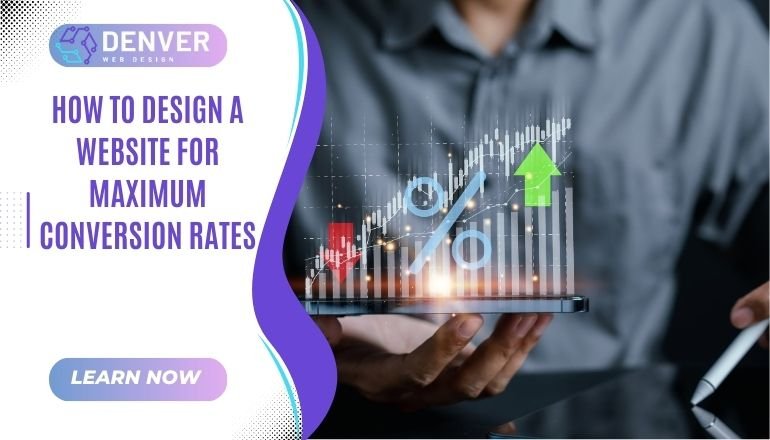
Designing a website that converts visitors into customers is a top priority for any business with an online presence. Whether you’re launching a new site or optimizing an existing one, focusing on conversion rate optimization (CRO) is key to driving business growth. A website that effectively captures leads and drives sales needs to be well-designed, fast, and user-friendly. This guide will explain how to design a website with conversion optimization at its core. For those looking to take it a step further, Web Design Denver offers expert web design and development services to create a seamless path to success.
What Is Website Conversion Rate Optimization (CRO)?
Website conversion rate optimization, or CRO, refers to the process of improving your website’s design and functionality to increase the percentage of visitors who take a desired action. This could include purchasing a product, signing up for a newsletter, or filling out a contact form. Essentially, the goal is to make your website not just attract traffic, but convert that traffic into tangible business results.
Key concepts related to CRO include SEO-optimized websites, where design works in harmony with search engine strategies, and responsive web design, ensuring that your site works seamlessly across devices. Understanding these aspects allows you to prioritize design choices that boost conversions across various user scenarios.
Why Is CRO Essential for Your Website?
A website with high conversion rates provides direct value to your business. Here’s why designing for CRO matters:
- Increased Revenue
Optimized websites convert more visitors into customers, directly boosting revenue. Elements like intuitive navigation and clear calls-to-action (CTAs) are foundational in nudging visitors toward purchasing or signing up. - Improved SEO and Traffic
While great user experiences lead to higher conversion rates, they also improve SEO performance. Google ranks websites with excellent user engagement (low bounce rate, fast load times) higher, ultimately driving more organic traffic. - Competitive Advantage
A well-designed, optimized website offers a clear advantage over competitors who neglect conversion-focused design. If users can find what they need quickly and easily, they are more likely to stay on your site and convert.
This is where working with expert services, like those offered by Web Design Denver, ensures that every component of your site is crafted to maximize conversion potential.
Key Features of a High-Converting Website
Designing a website for maximum conversion rates requires understanding the core elements that influence user behavior. Here are the key features that boost conversions:
- Clear and Persuasive Calls-to-Action (CTAs)
CTAs are essential for guiding visitors to take action. They should stand out but not overwhelm the design. A conversion-optimized website often uses CTAs like “Buy Now,” “Learn More,” or “Sign Up for Free” at strategic points. - Streamlined User Experience (UX) Design
A smooth user journey is critical to conversion. Elements like easy navigation, quick access to important content, and clear search functions play an essential role. - Mobile-First Design
With a mobile-first approach, users on mobile devices experience a layout optimized for their screen size, reducing bounce rates and improving engagement. - Loading Speed Optimization
A fast-loading website provides a better user experience and encourages users to stay longer, which increases conversion chances. - Social Proof and Trust Signals
Reviews, testimonials, and trust badges are vital for establishing credibility. Users are more likely to convert on websites that inspire trust.
Best Practices for Designing for Conversions
- Optimize for Speed
A fast website is one that performs better. Focus on site speed by compressing images, reducing scripts, and leveraging efficient coding. - Implement A/B Testing
Testing different variations of a page allows you to determine which design elements, copy, or visuals drive more conversions. - Keep Navigation Simple and Intuitive
Ensure that your website’s navigation is straightforward. Minimize the number of clicks needed to reach essential content, like product pages or the checkout process. - Mobile-Friendly and Responsive Design
Designing for both mobile and desktop experiences ensures no user is left behind. Make sure your layout adjusts to various devices and screen sizes. - Use Persuasive and Clear Content
Your website copy should convey trust, value, and clarity. Include strong headlines, bullet points, and well-designed CTAs.
Focusing on these best practices in web design ensures you maximize conversion rates across all visitors, a critical strategy for increasing revenue and engaging your audience.
Common Mistakes to Avoid in Conversion-Focused Web Design
- Cluttered Layouts
Overcrowded designs can confuse visitors and hurt conversions. Keep things clean and ensure there’s enough white space to make the site feel breathable and easy to navigate. - Neglecting Mobile Optimization
More users access websites via mobile, so ignoring mobile-first design or creating responsive layouts that don’t adapt properly can harm conversions. - Weak CTAs
Vague or poorly placed CTAs can be a conversion killer. Make them clear, actionable, and visually prominent to guide users to their next step. - Slow Page Load Times
A delay in loading speed may prompt visitors to leave before the page even fully loads, costing you potential conversions.
Conclusion: Key Takeaways for Boosting Conversion Rates
Designing a website for maximum conversion rates is more than just aesthetics; it involves understanding the psychology behind user behavior and optimizing your site’s layout accordingly. From creating clear calls-to-action to focusing on mobile-first design, your website’s structure should aim at smooth navigation, fast speeds, and user-friendly experiences.
To take the next step in achieving website success and conversions, explore how Web Design Denver can help with professional web development and customized conversion rate optimization solutions. Let’s start optimizing your site today!






